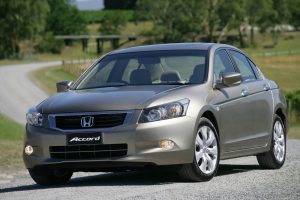Recalls: Honda CP2/CP3 Accord
Overview
Manufacturers, or importers, issue recalls for defects or faults which have the potential to cause injury. Generally, manufacturers will inform the original buyers if their vehicle is subject to a recall and of the steps required to remedy the defect or fault. Please note that the recalls below (if any) are for Australian-delivered vehicles only. Furthermore, the number of recalls should not be taken as an indication of a model’s reliability or its safety more generally.
Recalls: Honda CP2/CP3 Accord
2008-11 model year Honda Accord: Takata airbag recall #1
In July 2016, a recall was issued for 2008 to 2011 model year Honda Accord vehicles and this recall was updated with new information in September 2017. In these vehicles, propellant wafers in the airbag inflators could absorb moisture over time, causing overly aggressive combustion if the airbag was deployed – this would create excessive internal pressure that could cause the airbag inflator housing to rupture and scatter metal fragments through the airbag cushion material. These scattered fragments could cause serious injury or fatality to vehicle occupants. For the VINs of the recalled Honda Accord vehicles, please see PRA 2016/15494.
2012 model year Honda CP2/CP3 Accord: Takata airbag recall #2
In January 2017, a recall was issued for 2012 model year Honda CP2/CP3 Accord vehicles and this recall was updated in September 2017 with new information. In these vehicles, propellant wafers within the front passenger airbag were susceptible to moisture intrusion over time. In the event of an airbag deployment, this could cause overly aggressive combustion of the airbag such that the airbag inflator housing could rupture. If this occurred, metal fragments could pass through the airbag cushion material and scatter throughout the cabin, posing a risk of serious injury or fatality to vehicle occupants. For the VINs of the recalled Honda CP2/CP3 Accord vehicles, please seePRA 2017/15859.
2008-10 model year Honda CP2/CP3 Accord: Takata airbag recall #3
In October 2019, recall campaign 6EE was issued for 2008-10 model year Honda CP2/CP3 Accord vehicles. These vehicles had been fitted with a complete driver airbag assembly that was determined to contain an affected Takata airbag inflator. Takata driver airbags contained propellant wafers which could absorb moisture over time. In the event of airbag deployment, excessive pressure in the airbag inflator housing could cause it to rupture so that metal fragments could be projected through the airbag cushion into the vehicle’s cabin. These metal fragments posed a risk of serious injury and fatality. For the VINs of the recalled vehicles, please see PRA 2019/17660.
Search online for recalls by VIN
To see if a Honda vehicle has been recalled, you can conduct a search on the Honda Australia website using its VIN.
Problems and faults: Honda CP2/CP3 Accord
Overview
This section identifies potential problems, causes and fixes based on the experiences of owners and repairers, online sources and technical service bulletins. This information is provided solely for reference purposes and AustralianCar.Reviews recommends that only properly qualified persons carry out repairs or modifications. Furthermore, the number of items below should not be taken as an indicator of a model’s reliability or the frequency with which they may occur.
To report a problem or fault to the AustralianCar.Reviews team, please use the Contact Us form. Note that AustralianCar.Reviews does not offer advice on automotive problems or disputes; such enquiries will not receive a reply. For vehicles purchased from dealers after 1 January 2011, please see our Australian Consumer Law fact sheet.
Honda CP2 Accord: engine rattle on start-up
In October 2011, Honda USA issued service bulletin 09-010 for 2008-09 Honda CP2 Accord vehicles. In these vehicles, the engine may rattle loudly for about two seconds immediately after a cold start due to a defective variable valve timing (VTC) actuator. The service bulletin described the replacement procedure for the VTC actuator (part no. 14310-R44-A01.
Honda CP2 Accord: low oil level
In August 2013, Honda USA issued service bulletin 12-087 for 2008-11 Honda CP2 Accord vehicles. In these vehicles, the engine oil level may become low and, in rare cases, the oil warning light may illuminate. The service bulletin identified that the engine may create deposits on the oil control rings which could lead to increased oil consumption when the following occurred simultaneously and on a regular and prolonged basis:
- The engine was cold (i.e. not warmed up to operating temperature);
- Hard acceleration when the engine was cold; and,
- The petrol used had an unusually high concentration of particles.
If the oil control rings began to stick because of the deposits, excessive oil consumption could result. The service bulletin recommended that an oil consumption test be performed and, if necessary, all the pistons and piston rings be replaced.
Honda CP3 Accord: moaning/whining when turning steering wheel
In April 2009, Honda USA issued service bulletin 07-086 for Honda CP3 Accord V6 vehicles because of a moaning or whining noise when the steering wheel is turned and the engine is cold. According to the service bulletin, this noise may be due to air entering the power steering pump through the inlet joint O-ring – this caused bubbles to form in the power steering fluid and adversely affected the operation of the steering pump. To fix, the O-ring on the power steering pump inlet joint was to be replaced (part no. 91345-RDA-A01, H/C 8811010).
Problems and faults: Honda CP2/CP3 Accord
- For Honda Accords with the 3.5-litre V6 engine, a chirping noise from the timing belt area of the engine bay may be due to a cocked idler pulley; an angled spacer (or shim) is required to fix.
- If the parking brake light stays on, the circuit board in the hands-free link in the roof console may be defective.
- On models fitted with a satellite navigation system, the clock may randomly display the wrong time. To fix, the navigation unit may need to be replaced.




